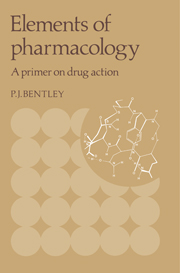Book contents
- Frontmatter
- Contents
- Preface
- 1 Introduction
- 2 Scope of pharmacology
- 3 Where do drugs come from?
- 4 The names of drugs
- 5 Techniques and methods of pharmacology
- 6 Absorption, distribution, and elimination of drugs; pharmacokinetics
- 7 The nature of responses to drugs
- 8 Receptor theory
- 9 Relationship of chemical structure to biological activity
- 10 Roles of the cell membrane in responses to drugs
- 11 Clinical aspects of the actions of drugs
- 12 Conclusion
- References
- Glossary of drugs named in the text
- Index
3 - Where do drugs come from?
Published online by Cambridge University Press: 29 January 2010
- Frontmatter
- Contents
- Preface
- 1 Introduction
- 2 Scope of pharmacology
- 3 Where do drugs come from?
- 4 The names of drugs
- 5 Techniques and methods of pharmacology
- 6 Absorption, distribution, and elimination of drugs; pharmacokinetics
- 7 The nature of responses to drugs
- 8 Receptor theory
- 9 Relationship of chemical structure to biological activity
- 10 Roles of the cell membrane in responses to drugs
- 11 Clinical aspects of the actions of drugs
- 12 Conclusion
- References
- Glossary of drugs named in the text
- Index
Summary
Until the latter part of the nineteenth century, drugs and medicines were all obtained from natural sources, usually plants, sometimes minerals, and occasionally animals. Plants were, however, the predominant sources of drugs, and proliferated considerably as such because of a cultural pooling of herbal remedies, poisons, and pharmaceutical confectionary following the expansion of trade and the geographic explorations in the Middle Ages. In England the leaves of the purple foxglove (Digitalis purpurea) provided the cardiac glycosides that are still used to treat congestive heart failure. (The skin of toads was apparently also used as a source of these compounds much earlier in China.) The pain-relieving and pleasurable properties of opium, which is obtained from the seed capsules of the poppy Papaver somniferum, were probably first exploited in ancient times in Mesopotamia and Persia. The ubiquitous effects of the Rauwolfia alkaloids, which include reserpine, were first utilized in India where they are obtained from the root of the snakeroot plant (Rauwolfia serpentina). Today reserpine can be used to control high blood pressure, but it has also enjoyed a vogue in the treatment of psychoses. Tubocurarine is used as a muscle relaxant during anesthesia, but this plant alkaloid (from tropical vines of the family Menispermaceae) was first used as an arrow poison by the Indians who lived around the Amazon river. The bark of the cinchona tree (Cinchona ledgeriana), also from South America, is the original source of quinine and quinidine, which are used, respectively, to treat malaria and irregular rhythms of the heartbeat.
- Type
- Chapter
- Information
- Elements of PharmacologyA Primer on Drug Action, pp. 4 - 6Publisher: Cambridge University PressPrint publication year: 1981



